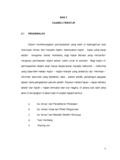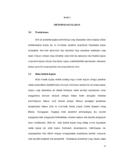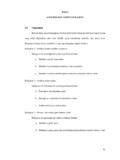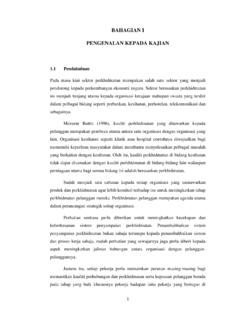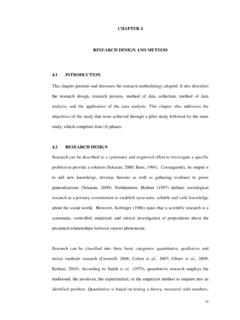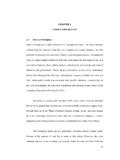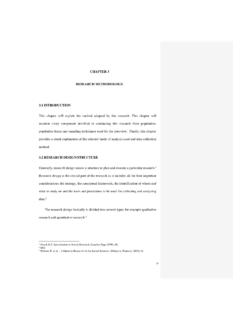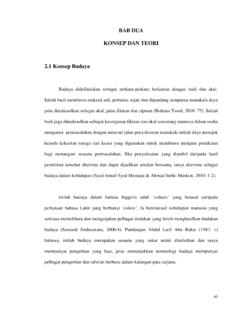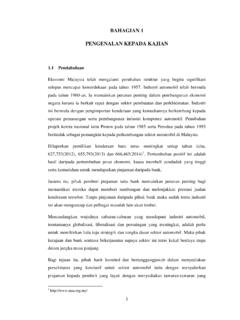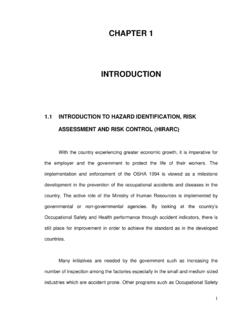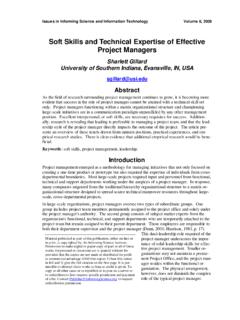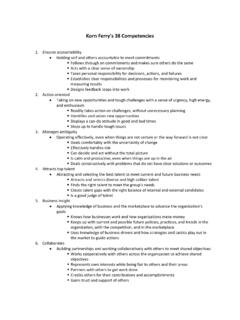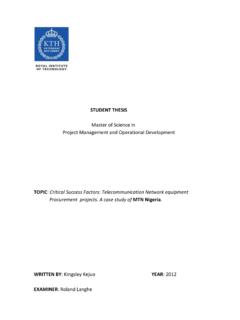Transcription of 2.1 Solid Waste Management (SWM)
1 CHAPTER 2: LITERATURE REVIEW. Solid Waste Management (SWM). Solid Waste Management has become one of a major concern in environmental issues (Mazzanti & Zoboli, 2008). This is particularly true to urban areas where population is rapidly growing and amount of Waste generated is increasing like never before (Kathiravale & Mohd Yunus, 2008). Current earth's population is billion and it is estimated that almost half of this population lives in urban areas (Population Division of the Department of Economic and Social Affairs of the United Nations Secretariat, 2009). Waste generation increase proportionally to this population number and income, creating the needs of effective Management (Mazzanti & Zoboli, 2008). Urbanization and industrialization leads to new lifestyles and behavior which also affects Waste composition from mainly organic to synthetic material that last longer such as plastics and other packaging material (Idris et al.)
2 , 2004). E- Waste that barely existed before was generated as much as 20-50 metric tons a year (UNEP, 2006). The Management of Waste become complex and the facilities provided cannot cope with the increasing demand and needs. Therefore, best approach need to be implemented immediately while considering environmental, social and economic aspects (Aye &. Widjaya, 2006). The drivers of sustainable Waste Management were clarified by Agamuthu et al. (2009), which include human, economic, institutional and environment aspect. The study suggests that each driving group should be considered in local context as managing Solid Waste for a particular society may differ from the others. 10. For example, Waste managers in Africa need to tackle some issues including, lack of data, insignificant financial resources, vast different of amount and Waste types between urban and rural area, lack of technical and human resources, low level of awareness and cultural aversion towards Waste (Couth & Trois, 2010).
3 On the other hand, problems faced among Asian countries differ with two distinct groups; developed and developing countries. While some of the countries are having specific national policy on Solid Waste Management , some others experience problems such as increasing urban population, scarcity of land, services coverage area, inadequate resources and technology , and so on (Shekdar, 2009). The differences in managing Solid Waste not only vary between countries but also among areas in the same country. For instance, while Istanbul are having big improvement in their Solid Waste Management with the establishment of transfer stations, sanitary landfills and methane recovery system, it does not reduce the problem in the Black Sea coast in Turkey.
4 This is caused by the complex topography, weak administrative structures and the low local's income (Berkun et al., 2005). Integrated Sustainable Waste Management (ISWM) system was then introduced in 1995 to improve earlier system that neglect unique characteristics of a given society, economy and environment (van de Klundert, 1999). For example, European countries had applied various system assessment tools and engineering models to create sustainable communities, manage resources efficiently, tapping innovation potential of the economy, ensuring prosperity, environmental protection and social cohesion in their SWM system (Pires et al., 2011). Asian countries had also given attention in building the national legal 11.
5 Frameworks, managing institutional, technology , operational and financial aspects, and creating public awareness and participation (Shekdar, 2009). The Waste Management system should be dynamic and continuous based on new insights and experiences (van de Klundert, 1999). For example, continuous assessment of current policy and regulatory framework of New Zealand indicated the lack of policies coordination, hazardous Waste Management , consistency, incentives and markets for recycled material, and cleaner production effort (Boyle, 2000). Thus, the improvement in policy is needed while it will also benefit the country. As an example, based from EU25. group, it was found that the generation of Waste is increasing and is expected to continue for many years ahead.
6 After the implementation of the new EU's policy in Waste recovery and incineration, the amount of Waste landfilled has been decreasing slowly (Mazzanti &. Zoboli, 2008). However, based from the data from developed countries, the actual amount of Waste been landfilled is actually decreasing as more Waste are incinerated, composted or recycled. Looking at the positive angle, Lomborg (1998) believed that area needed is sufficient to cater the total amount of Waste generated by the world, but the problem is the location since nobody wants to stay near landfills. He also reported that air from incinerators and groundwater near landfills today are cleaner and safer. Therefore, Solid Waste generation can be considered more of a political or social issue than others (Lomborg, 1998).
7 A lot of literature has discussed current practices, challenges and future solutions on Waste Management such as those for India (Hazra & Goel, 2009), Portugal (Magrinho et al., 12. 2006), Canada (Wagner & Arnold, 2008) and Malaysia (Agamuthu et al., 2009). These studies allow comparison to adopt the best practice wherever applicable. Solid Waste Generation Waste generation is the most important aspect to look at in order to have effective Solid Waste Management system. The generation of Waste varies considerably between countries based on the culture, public awareness and Management (Hazra & Goel, 2009; Wagner &. Arnold, 2008; Magrinho et al., 2006). Generally, developed countries generate more Waste than developing countries (Kathiravale & Mohd Yunus, 2008).
8 Countries in Asian and African region produce Waste in the range of tons/ capita/ year, while European countries generate higher amount of Waste with tons/ capita/ year (Intergovernmental Panel on Climate Change [IPCC], 2006). The generation of Waste is also reported to be associated with the economic status of a country. In Asia, countries with higher GDP, namely Hong Kong and Japan were reported to generate more Waste compared to developing countries such as India, Vietnam and Nepal (Table ) (Shekdar, 2009). Waste composition from these countries also differs where rural areas often produce more organic Waste and fewer recyclable items (Idris et al., 2004). 13. Table Gross domestic index (GDP) and Waste generation on selected Asian countries Country GDP (PPP) per capita Waste generation estimated for 2007(USD) (kg/capita/day).
9 Hong Kong 37 385 Japan 33 010 Singapore 31 165 Taiwan 31 040 South Korea 23 331 Malaysia 12 702 Thailand 9426 China 8854 Philippines 5409 Indonesia 5096 Sri Lanka 5047 India 3794 Vietnam 3502 Lao PDR 2260 Nepal 1760 Source: Shekdar, 2009. Developed countries are experiencing high Waste generation while developing countries always have problems with the implementation of the Management system (Hazra & Goel, 2009; Bai & Sutanto, 2002). This includes weak enforcement, lack of technology and ineffective policy implementation (Agamuthu et al., 2009). In detail, these countries experience low and irregular collection of Waste , uncontrolled of air and water pollution in open dumping area, the breeding of flies and vermin, and the mismanagement of scavenging activities (Latifah et al.)
10 , 2009). Looking at the Waste generation trend of developed country, it is believed that other transition and developing countries will experienced the same. Until recently, the generation of Waste is increasing and it is believed to continue rising. This is an issue of concern for authorities all over the world. It is believed that the amount of Waste will 14. continue to pile up the landfill and someday the land will not be able to receive anymore Waste . Solid Waste Disposal Information on Waste generation is important to determine the most suitable Waste disposal options. Improper Waste disposal may cause pollution. The main purpose in implementing best practice for Solid Waste Management is to prevent pollution.
